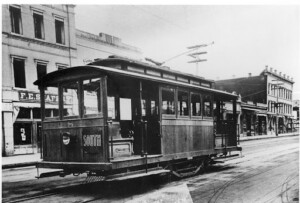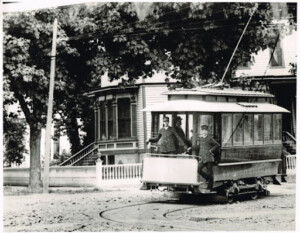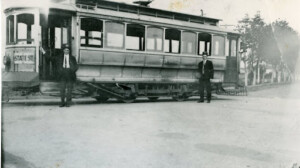Salem’s First Streetcar Line
On January 1, 1889, the Rev. J. L. “Father” Parrish, last survivor of Salem’s missionary founders, seized a broadaxe that had known the hand of Jason Lee, wound himself up and hammered home the first spike for Salem’s first streetcar line. On April 16, 1868, Father Parrish had driven, in East Portland, the first spike for the Oregon and California Railroad.
Streetcars for Salem were not a new thought. The City Directory for 1871 states that a company had been incorporated for conveying people from one part of the city to another with safety and dispatch.
Seventeen years later on October 31, 1888, a number of prominent Salem business men met in parlors of the Capitol National Bank to discuss realistically proposals for building a streetcar line in Salem. H. W. Cottle was named president, C. B. Moores, secretary, and J. J. Shaw, Squire Farrar, and C. B. Moores, committeemen, to prepare articles of incorporation. Capital stock was authorized to the amount of $20,000 for building a horse car line.
Oregon’s legislative session convened in mid-January of 1889. The state capitol under construction for nearly twenty years was yet incomplete; a stately dome that would give the structure distinction had not been built. Promoters of the horse car line were disposed to believe that legislators, soon to arrive, should be duly impressed by the Capitol City’s progressiveness in way of transportation from the depot to the capitol and downtown streets. Then, surely, they would favor appropriations for building a dome and completing the State House. (Construction of the dome did not begin until 1892.)
Laying tracks
November 3, 1888, saw articles of incorporation filed and on November 5, stock books were opened. Within four days an amount necessary for the company to organize had been pledged. On November 8, t. H. Hubbard, J. H. Albert, C. B. Moores, H. W. Cottle, and R. J. Hendricks were named directors. On that same evening R. J. Hendricks was chosen president for Salem Street Railway Company, t. H. Hubbard, vice-president, C. B. Moores, secretary, and J. H. Albert, treasurer.
New officials authorized construction without delay. On November 22, a contract for building the carline was let to O’Connor, Barr, and Horrigan. They agreed to build nearly 1½ miles of track and furnish all materials for $6,595. On December 27, two horse cars manufactured by Brownell and Wight, St. Louis car founders and builders, arrived in Salem. Contractors said, on December 28, that they were expecting railroad iron in a day or two and then work would be pushed. Next, in a more or less impromptu ceremony, elated citizens saw Father Parrish spike the first rail to the first tie on January 1, 1889.
Came January 10, 1889, and construction crews working around the clock were grading and placing track at State and Commercial streets. Work however, had started in front of the State Insurance Building, now the Star Exchange at 311 Commercial Street, N.E. This was the downtown terminal for the horse car line.
The first regular trips over a half-mile of track started during the afternoon of January 16, and reached the State House. Delays in delivery of certain supplies retarded progress, and regular trips to the Oregon & California depot, set for January 26. Few incoming legislators remained to be impressed.
City ordinance No. 183 granted Salem Street Railway Company a thirty-year franchise to operate on Center Street, Commercial northward to the city limits, on State Street from Liberty to Eighteenth, on Twelfth from State to the city limits, on Winter from Court to the city limits and on State west of Liberty. Fare was not to exceed five cents a person, and 15-minute schedules were set from 6 a.m. to 7 p.m. and 20-minute intervals from 7 p.m. to 11 p.m.
Horse cars were double-ended, closed and broad gauge but mounted on narrow gauge trucks. Seating capacity was sixteen passengers. Each car bore a name that was its destination: Depot, State House, and commercial Street. The total cost was $7,500. Two additional summer cars were ordered on May 27, 1889.
Salem’s horse car line reached the fairgrounds via Commercial Street during the summer of 1889, and in the autumn of that year an extension was laid up Center Street to the East School (now the site of Safeway’s store at Twelfth and Center streets.)
Hoover and mass transit
- J. Tichenor, who lived at 2833 N.E. Flanders Street, Portland, in 1950, informed this writer that he was the third driver employed by Salem Street Railway Company. Henry “Frosty” Price was the first and James Penland the second. Drivers were paid $2 for a day that started at 6 a.m. and ended at 9 p.m. Each driver worked his horses in three-hour shifts and, all in all, the animals got the breaks.

Trover, 1909-04-04, Streetcar on Commercial Street. Holman Building at left. Capital Hotel at right. Photo taken April 4, 1909., WHC Collections 2004.010.0757
Each car was equipped with a built-in fare box into which the passenger dropped his fare. Honesty of drivers was not questioned: it was simply too much to expect a man handling the lines, watching out for passengers and movement of the car to accept or make change.
Tichenor recalled that Herbert Hoover, then a ward of his uncle, Dr. Henry J. Minthorn, line official, never regularly drove a horse car. Rather, he was engaged in office work to earn money to finance his studies in mining engineering at Stanford University. (“In 1889-91 Herbert Hoover, as a young boy dressed in uniform, worked as a conductor on both of these cars. Hoover’s uncle, Dr. Henry J. Minthorn, was President of the Oregon Land Company which owned the horse-drawn streetcar line.” Stations West, The Story of the Oregon Railways. Culp. 1972. Editor’s note: Included in this book is a letter from Herbert Hoover attesting to the fact that he worked as a streetcar conductor around 1889-91, editor.)
Twenty years ago this writer was directed to an old Salem horse car in use as a chicken house at the rear of the W. H. Burger residence, 1745 Chemeketa Street. Faded letters identified it as the Commercial Streetcar. The coach measured ten feet in length and six wide. A well-preserved sign admonished “No Smoking.”
A report published on January 3, 1890, states that the Salem Street Railway Company was operating over five miles of track (and) had five cars and seventeen head of horses. Between eight and nine men were regularly employed. The total investment amounted to $40,000.
A little more than a year after its inception, when Dr. Henry J. Minthorn, president, was the Oregon Land Company principal stockholder, the horse car line was in financial distress. Generous financial assistance, ten more horses, and three new cars were deemed essential to keep the line in operation. Reorganization followed, giving the line a new name: Salem Motor Railway Company. On August 6, 1892, the company was allowed a thirty-day interval of suspension to complete electrification of its system.
In 1897, the Salem Motor Railway Company passed to the Salem Suburban Railway Company at a receiver’s sale. But before the line lost its identity, tracks had been extended into Highland Addition where Dr. Minthorn was promoting a real estate development and a polytechnic school.
Going Horseless

Salem streetcar at the corner of Liberty and Chemeketa Streets. This Capital City Railway Company streetcar would travel to the Insane Asylum (later the Oregon State Hospital)., WHC Collections x2014.023.0018
Capital City Railway Company, the electric line that outmoded and embarrassed the horse car system, was organized on November 19, 1889. Sponsors were Rev. P. S. Knight, David Simpson, George W. Webb, Otto Krausse, W. T. Gray, M. C. Chamberlin, and Louis Kuhn. Ordinance No. 188 granted the electric company authority to build its lines on Liberty Street, Chemeketa, State to the penitentiary, on eighteenth between Chemeketa and State, on Capitol and on Court Street. The purpose of this line, with a thirty-year franchise, was to bring property in East Salem into closer contact with the downtown area. An initial stock subscription amounted to $25,000, but the amount was later increased to $50,000.
A power house provided with a steam and water-powered dynamo was built on State Street near the site of the old oat meal mill (at the junction with North Mill Creek). Later a car barn was built nearby. (Editor’s note: “This barn appears as the Salem Light and Traction Company’s Car House at the Duck Inn site in the 1895 index to the Sanborn maps. It was located on a half-block along the millrace east of the main channel. Large concrete piers from this building were discovered when excavating for the Duck Inn.” From Marion County History, Volume XV. P. 90, Lloyd Chapman. )
On May 27, 1890, a Capital Journal reporter was invited to ride on an initial, shake-down run over about 2½ miles of track extending up Chemeketa Street to Eighteenth, thence to State and eastward to the penitentiary. He reported the cars as moving off smoothly, a characteristic not associated with the horse cars. A motor of 15-horsepower operated the car at a rate of about twelve miles an hour. But when it came to explaining just how electricity made the car run the reporter was baffled.
A few days later the reporter was invited to ride the electric car from downtown Salem to Rural Cemetery. He was gratified the way the car walked right up Gaiety Hill with a full load and then made the 1600-foot grade beyond with a rise of 60 feet, in two minutes. May 31, 1892, was excursion day for the electric system with cars running from the penitentiary to Rural Cemetery, a distance computed as five miles, for a fare of three cents.
Expansion of the lines

1920, State Street Rail Car #73 photo, dated 1920. Two conductors visible, one at front and one at back of car. Line of trees in back right of image. Handwritten note on back: Salem Ore. streetcar 1920., WHC Collections 2021.041.0015
Early in the 1890’s Salem was embarrassed by an excess of street rail transportation. The Motor Railway was laying track up State Street and on grade as ordered by the Council. On the lower end it was two feet above the street surface and two feet below on the upper end. Capital City’s new track, being laid on the same street, was on actual grade. One track was in the center of the street, the other on the north side. Street car tracks had taken half of this important street for their own use.
At best, the Capital Journal reported, this street was poor enough when wagons could pick the easy part of it to travel over. Now it was in horrible condition, to say the least. Business interests and the good name of our city should demand that State Street be made passable.
Extension of Capital City lines into various sections of the city went on apace during early years of the Company’s existence. A Seventeenth Street extension to the Fairgrounds began operating during June of 1891. Through service to the Fairgrounds via this street was discontinued in 1894 with the terminal a Garden Road (Market Street – Ed.). Then, in 1899, this extension from Asylum Avenue to Garden Road was discontinued and operations were not resumed until October 6, 1904.
A gold medal
On September 8, 1890, a Salem newspaper told of a new trailing car under construction by Salem Iron Works for the electric company. The Company offered the first woman who obtained a seat in the new car on its first run a gold medal. John g. Wright, Salem pioneer merchant, nudged shy, thirteen-year-old Clara Churchill into making a run for it. She won the handsome medal made by W. W. Martin, Salem’s leading jeweler in 1890.
On November 29, 1897, F. R. Anson, receiver for the Salem Electric Railway notified the public that the cars would leave Willamette Hotel (now the Marion) for the Southern Pacific depot via the State House, for the Insane Asylum with a transfer to Garden Road available and to South Salem. Cars left the Methodist Church on State Street for Morningside and the Fairgrounds. Cars operated on twenty- and thirty-minute schedules.
A streetcar funeral
Davis Cooley, Salem nonagenarian now residing at 1175 Capitol Street, told the writer that a funeral in the early 1890’s used a summer car on the Capital City line as a hearse. The casket was placed crosswise on a seat and pallbearers accompanied the casket to Rural Cemetery. From the car they carried the casket uphill to the grave site.
The decline and end of streetcars
About this same time a young lady new in Salem wrote her dear mama to say that the city’s streetcars took people to the Asylum, Penitentiary, and the Cemetery.
Depression times in the 1890’s brought consolidations, receiverships, and a labyrinth of litigation for Salem’s streetcar systems. After 1895 there was little or no extension of lines for a decade to come. In 1900 about twelve miles were in operation.
In 1896, F. R. Anson and associates acquired control, if not ownership of the city’s rail transportation system. In 1903, Joseph J. Henry of Denver had a controlling interest, in 1907 Portland General Electric company, and in 1912 Portland electric Power Company. Last known owner was Southern Pacific.
In 1905 a contract was signed for construction of a carline from the South Commercial Street terminal to Liberty. Service was promised after January 1, 1906. Early in 1910, Portland, Eugene & Eastern had extended their carline over six blocks on Center and Summer streets. This line was projected to the Fairgrounds but dead-ended in a field before reaching that destination.
A newspaper story published on May 19, 1921 credits T. L. Billingsley, superintendent of Salem’s streetcar system, with telling the Marion County Realtors’ Association that “the city’s street railways have not paid in 30 years.” He went on to say that he had been associated with the city’s carlines since 1912 and that since that time the Company had not received even operating expenses. He pointed out that the investment in Salem’s street rail transportation was $458,000 and that total loss to the operating company in 1920 was $43,000.
Street buses replaced carline service on the Seventeenth Street extension on November 24, 1924. On July 29, 1927, Salem newspapers told of busses operating on State Street. On August 4, 1927, Superintendent Billingsley reported that there had been no hitch at all in Salem’s complete switch-over from streetcars to buses.
By Ben Maxwell, Compiled by Clarence Pugh
Bibliography:
Marion County History, Volume XV, SESNA Development, Trolleys. Lloyd Chapman.
Salem’s First Streetcar Line. Ben Maxwell
This article originally appeared on the original Salem Online History site and has not been updated since 2006.







Leave A Comment